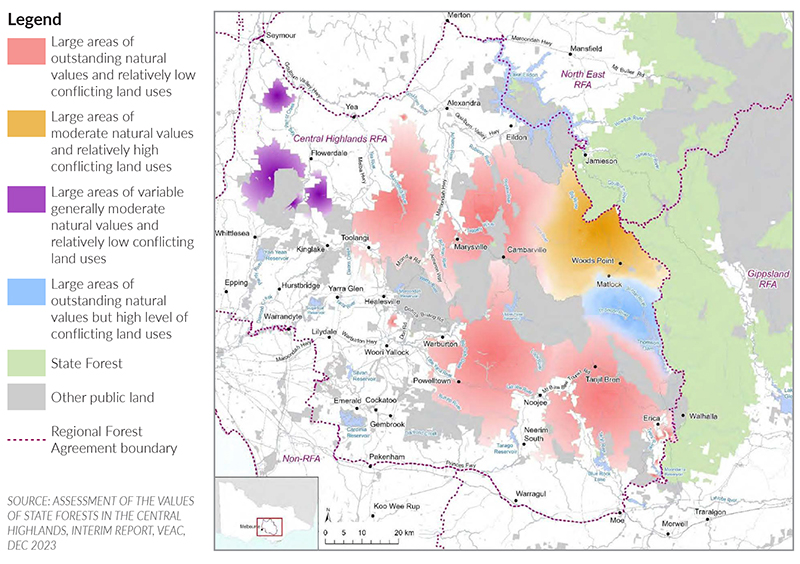PARK WATCH Article March 2024 |
Matt Ruchel, VNPA Executive Director says it’s finally time for the Great Forest National Park
For decades there has been a community push for better protection of the Mountain Ash forests of the Yarra Ranges and surrounds. Now we’ve seen the end of native forest logging, it’s the time to get on with it.
In the 1990s, VNPA ran a campaign for an expanded national park in the Central Highlands.* Originally proposed as the Ash National Park, but later changed to the Yarra Ranges National Park, the 76,000 ha park was legislated in 1995. It included many of the existing closed water catchments but fell far short of what was required. Reports from the 1994 Land Conservation Council (LCC) – the body predating the Victorian Environmental Assessment Council (VEAC) – clearly articulated the reasons for this.
[The LCC are]…proposing a considerable smaller park than that suggested by conservation groups… as it wishes to ensure that sufficient timber resources is available to meet the needs of the timber industry.
And it stayed that way for the next three decades.
A concerted 2010 campaign by VNPA and other conservation groups came close to obtaining a commitment from the incoming Andrews Labor Government. Their 2014 environment policy, the last comprehensive environment election policy by any major party in Victoria, announced a Forest Industry Taskforce. Its purpose was:
…to reach common ground on the future issues facing the industry, job protection, economic activity, protection of our unique native flora and fauna and threatened species, such as the Leadbeater’s possum.
The taskforce, which VNPA was represented on, had intensive discussions for around two years. It was prematurely abandoned by the timber industry, who preferred to fight rather than innovate. An undeniably challenging task, some important work was triggered, but it clearly revealed the perilous state of the forest and the forestry industry. It was, in part, a precursor to the final announcement of the end of native forestry in 2023. The final nails in the forestry coffin were the successful court cases run by community conservation groups and continued financial losses.
With commercial native forest logging finally ended on 1 January 2024, the time has come to create the Great Forest National Park and protect other important parts of eastern Victoria, now free of logging.
Long list of assessments
So-called Immediate Protected Areas, announced in 2019, covered some parts of Central Highlands, but the process established to formalise them lagged.
In December 2023, the first part of an evolved and expanded process was released: an interim report by VEAC, Assessment of the values of state forests in the Central Highlands. This work built on the 2017 assessment Conservation values of state forests, which was triggered by the Forest Industry Taskforce. These assessments, done under a relatively new power given to VEAC, do not have the weight of full-blown investigations, which require a government response after tabling in parliament. A full final assessment is due 31 July 2024, and will include other areas east of the Hume Highway.
This assessment will input into a newly created process – the Eminent Person Panel for Community Engagement– and work with a yet-to-be-announced additional advisory panel:
…to consider and make recommendations to Government on the areas of our forests that qualify for protection as National Parks, the areas of our forests that would be suitable for recreation opportunities… and opportunities for management of public land by Traditional Owners.
These randomly-created advisory and eminent panels are a divergence from full-blown expert and independent VEAC or LCC processes successful for over 50 years. Will they improve outcomes or are they just a further delaying tactic?
The Labor Government’s record on the formal creation of national parks is the slowest of any Victorian government in decades. Are they serious about getting end results, or do they just want to express intent? As we know, national parks are not created until they are legislated.
Now is the time
The most recent VEAC assessment highlighted that there are clear gaps in the reserve system to ensure a comprehensive, adequate and representative reserve system.
VEAC also highlights that a large, protected area such as a national park is commensurate with outstanding natural values (pink on the map) and would link the existing Yarra Ranges, Kinglake, Lake Eildon and Baw Baw national parks with the Bunyip, Cathedral Range and Moondarra state parks. They note that there are few uses that would conflict with a national park designation. The inference is that it should be straightforward to create a new national park.
The area around the Upper Thompson water catchment (blue shading on the map) was also identified as having high natural values, though there was an inference in the report that the area had competing lands uses, such as mining and hunting, and should be considered differently. But isn’t the point of national parks to avoid or eliminate these types of threats to natural values?
Two other areas west of the Kinglake National Park (purple shading) were identified as having lesser values and conflicting uses around Woods Point (orange shading). Due to the broad brush used, rather than the fine comb VEAC usually uses, this area has been classed as having lower values even though high value and vegetation communities exist within these areas. Room for new conservation parks or nature conservation reserves or additions to existing national parks should be on the table for these high conservation value areas. It would also be important to link the Toolangi Forest and Kinglake National Park.
VEAC did not provide detailed boundaries or recognise other park types, including conservation reserves and regional parks. Regional parks are often smaller and weaker in terms of tenure but do allow a wide variety of recreation uses and can be important as buffers, particularly around towns. The Great Forest National Park as a concept was always proposed as having a network of different tenures with a large national park at its core, along with the appropriate engagement, involvement and joint management of Traditional Owners.
Decades of science prove the value of the park and high community support – do we really need another panel? With native forest logging finished, now is clearly the time for a Great Forest National Park.
*At the time targeting the LCC, as part of 1994 Melbourne District Review 2.
- Read the latest full edition of Park Watch magazine
- Subscribe to keep up-to-date about this and other nature issues in Victoria
- Become a member to receive Park Watch magazine in print

